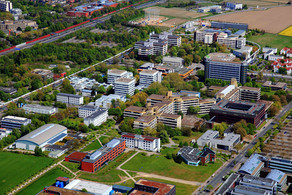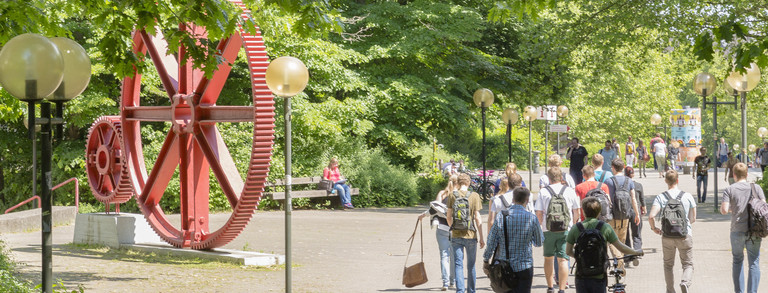Resource Management and Mobility
Waste
TU Dortmund University produces around 1044 tons of waste every year. The waste is separated (link to the intranet of TU Dortmund University) and recycled in accordance with legal regulations(Closed Cycle Management Law , State Closed Cycle Management Law, Waste Statutes of the City of Dortmund). Some waste fractions (metal and electronic scrap) are sold to disposal companies and fed into recycling processes. The disposal companies are adapted to the respective waste fraction.
Waste volumes are not currently collected in full every year. However, TU Dortmund University is striving to reduce the overall amount of waste. Some examples are:
- For furniture, a central furniture storage (E-mail address of the furniture store) allows furniture in gererally good condition to be used again.
- The Office of Occupational Safety, Environmental Protection and Health Protection often mediates between the various stakeholders at the university to ensure that chemicals are in good condition.
- To reduce paper consumption, TU Dortmund University follows the standard industry recommendations of only printing what is necessary and double-sided. In addition, paper consumption has been significantly reduced through the introduction of digital systems (SAP, course catalog, examination system). Corona-related online teaching and increased home office have further reduced paper consumption.
| Waste fraction | Amount |
|---|---|
| Residual waste | 568 t |
| Waste paper and cardboard | 109 t |
| Wood | 107 t |
| Hazardous waste | 83 t |
| Bulky waste | 51 t |
| Document destruction | 35 t |
| Green waste | 26 t |
| Scrap metal | 18 t |
| Construction and demolition waste | 18 t |
| Electronic waste | 17 t |
| Scrap | 8 t |
| Styrofoam | 4 t |
Source: Corporate Center Construction and Facility Management/TU Dortmund University
Water
Rainwater, wastewater and graywater
Whenever soil conditions permit, rainwater seeps into the ground on the Campus of TU Dortmund University. Temporary storage of rainwater for landscape maintenance is planned for the new university library.
A mixed water system is installed at TU Dortmund University. Due to the size of the wastewater network, there is an obligation to regularly check the condition of the network(Wastewater Self-Monitoring Ordinance). This allows any leaks to be detected quickly. Buildings that handle chemicals have a wastewater network that flows into a central neutralization system. There, the water is treated accordingly. Separation systems are installed at four points where oily wastewater could be produced.
There is no use of gray water on the campus of TU Dortmund University.
Water consumption
Comprehensive measures have reduced water consumption at TU Dortmund University from 350,000 m³ in 1980 to 114,000 m³ in 2022. For example, sensor-controlled taps are used on the washbasins and economy buttons on the toilets, experimental set-ups are cooled using recirculation cooling systems and the extinguishing and drinking water pipes are decoupled from each other. By separating the extinguishing and drinking water pipes, the amount of water that must be replaced every 72 hours to maintain water hygiene can be reduced.
Interactive Graphic. Source: Corporate Center Construction and Facility Management/TU Dortmund University
A bar chart illustrating water consumption over a five-year period (2018-2022). The Y-axis shows water consumption in cubic meters (m³) and the X-axis shows the years.
- 2018: 135,586 m³
- 2019: 148,716 m³
- 2020: 81,463 m³
- 2021: 88,875 m³
- 2022: 114,006 m³
Mobility
This section describes the framework conditions for mobility at TU Dortmund University. Measures that promote climate-friendly mobility behavior are dealt with in the chapter on greenhouse gas emissions (subchapter on greenhouse gas reduction programs).
Motorized individual mobility
The parking lot area, including all access roads, is 104,000 m2. Due to changes in the parking space regulations of the City of Dortmund, the parking space certificates must be revised, which will reduce the parking space area. To this end, the Bau- und Liegenschaftsbetrieb NRW (BLB NRW), TU Dortmund University and the City of Dortmund are developing district parking space regulations for the university (as of January 2024). There are no other programs to reduce the number of parking spaces.
Only commercial and delivery vehicles receive dedicated entry permits to the campus. There are no car sharing services in the immediate vicinity of the campus (as of January 2024).
There are three charging stations for electric cars with a total of seven charging points in the immediate vicinity of the campus (as of January 2024).
Public transport
TU Dortmund University is connected to public transport. The S-Bahn (S1) takes you to Dortmund city center within 10 minutes. The H-Bahn, a fully automated top-suspended monorail, connects the North Campus with the South Campus and various bus and night bus lines (440, 445, 447, 449, 462, 465, X13, NE8, NE40) connect the university with the surrounding suburbs. University students receive a semester ticket with their semester contribution, which they can use throughout NRW. From the summer semester 2024, the "Germany semester ticket" (Deutschlandsemesterticket) allows all students to use public transport throughout Germany. Employees had the option of using a job ticket. As of June 4, 2024, 156 job tickets were in use. As part of the tariff reform of the Rhine-Ruhr transport association (Verkehrsverband Rhein-Ruhr) on 1 March 2025, the Jobticket was discontinued, as the conditions of the Jobticket and the Deutschlandticket are identical.
Emission-free mobility
The campus of TU Dortmund University is largely a car-free pedestrian and cyclist zone. There are 11 metropolradruhr stations on and in the immediate vicinity of the campus. Students of TU Dortmund University can use the nextbike bike rental service throughout the Ruhr region free of charge for one hour per rental.




